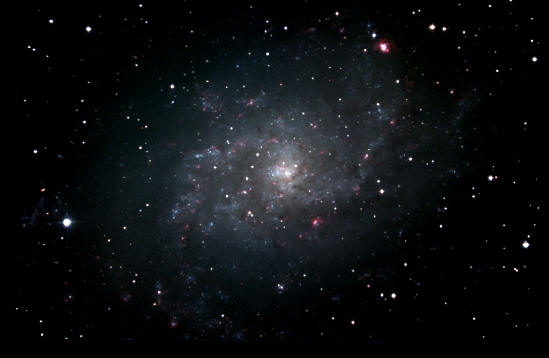|
The Sky of October
Dr. Wayne Wooten
Professor of Astronomy
Escambia Amateur Astronomers' Association
"For October, the Moon will be just past new on October 1st, passing five degrees below brilliant Venus in the west. The first two weeks of October will thus find the Moon waxing and rising later each evening. First quarter moon is on October 7th, with it passing about 3 degrees
sorth of Jupiter in the southern sky. The full moon occurs on October 14th , this is the ‘Hunter’s Moon'. The last two weeks find the moon waning in the morning sky. Last quarter moon is October 21st, and the waning crescent moon passes four degrees south of Saturn on
October 25th, and seven degrees south of Mercury on October 27th. New Moon is on October 28th. Halloween finds the moon a slender crescent, with the top lit by earthshine, to share with the trick or treaters in the evening twilight.
While the naked eye, dark adapted by several minutes away from any bright lights, is a wonderful instrument to stare up into deep space, far beyond our own Milky Way, binoculars are better for spotting specific deep sky objects. For a detailed map of northern hemisphere skies, about
September 30th visit the www.skymaps.com website and download the map for October 2008; it will have a more extensive calendar, and list of best objects for the naked eyes, binoculars, and scopes on the back of the map. Also available as the next month begins is wonderful video exploring the October 2008 sky,
featuring many different objects, available from the Hubble Space Telescope website at: http://hubblesite.org/explore_astronomy/tonights_sky/.
Venus dominates the evening in the west, setting almost two hours after the Sun as October ends. She appears as a gibbous disk, 86% sunlit and 12" across on October 1st. She will appear larger (14") but less lit (78%) by Halloween. Covered with sulfuric acid clouds, her bright disk reveals
no visible details in the scopes.
The Big Dipper falls lower each evening. By the end of October, it will be only the three stars in the handle of Dipper still visible in the northwestern twilight. By contrast, the Little Dipper, while much fainter, is always above our northern horizon here along the Gulf Coast.
To the southwest, Antares and Scorpius also set soon after twilight, and will be gone by month’s end. East of the Scorpion’s tail is the teapot shape of Sagittarius, which marks the heart of our Milky Way galaxy. Looking like a cloud of steam coming out of the teapot’s spout is the fine
Lagoon Nebula, M-8, easily visible with the naked eye. This stellar nursery is ablaze with new stars and steamers of gas and dust blown about in their energetic births. In the same binocular field just north of the Lagoon is M-20, the Trifid Nebula.

Just above the handle of Sagittarius’ teapot is bright Jupiter, dominating the southern sky now. Any small scope will reveal what Galileo marveled at in 1609; four large moons, all bigger or similar to ours in size, orbit it in a line along Jupiter’s equator. So get out the old scope, and
focus on Jupiter for a constantly changing dance of the moons around the giant world.
The brightest star of the northern hemisphere, Vega dominates the sky overhead. To the northeast of Vega is Deneb, the brightest star of Cygnus the Swan. To the south is Altair, the brightest star of Aquila the Eagle, the third member of the three bright stars that make the Summer Triangle
so obvious in the NE these clear autumn evenings.
To the east, the square of Pegasus is a beacon of fall. South of it lies the only bright star of Fall, Fomalhaut. If the southern skies of Fall look sparse, it is because we are looking away from our Galaxy into the depths of intergalactic space.
The constellation Cassiopeia makes a striking W, rising in the NE as the Big Dipper sets in the NW. Polaris lies about midway between them.
She contains many nice star clusters for binocular users in her outer arm of our Milky Way, extending to the NE now.
Her daughter, Andromeda, starts with the NE corner star of Pegasus’‘ Square, and goes NE with two more bright stars in a row. It is from the middle star, beta Andromeda, that we proceed about a quarter the way to the top star in the W of Cassiopeia, and look for a faint blur with the naked
eye. M-31, the Andromeda Galaxy, is the most distant object visible with the naked eye, lying about 2.5 million light years distant. It is a bigger version of our own Galaxy, which it may collide with about three billion years from now.
While not as big and bright as M-31, M-33 in adjacent Triangulum is also a member of the Local Group of Galaxies, and is one of the most photogenic in the sky. It is visible just south of beta Andromedae with binocs on a clear night, and EAAA member Ed Muntz captures the beauty of this
pinwheel of stars very nicely in our club photo feature for October 2008.
Read past issues of the Sky at Night
|